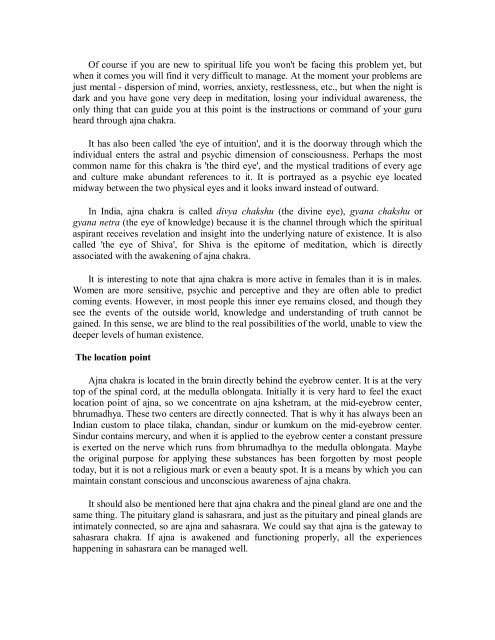Kundalini.Tantra.by.Satyananda.Saraswati
You also want an ePaper? Increase the reach of your titles
YUMPU automatically turns print PDFs into web optimized ePapers that Google loves.
Of course if you are new to spiritual life you won't be facing this problem yet, but<br />
when it comes you will find it very difficult to manage. At the moment your problems are<br />
just mental - dispersion of mind, worries, anxiety, restlessness, etc., but when the night is<br />
dark and you have gone very deep in meditation, losing your individual awareness, the<br />
only thing that can guide you at this point is the instructions or command of your guru<br />
heard through ajna chakra.<br />
It has also been called 'the eye of intuition', and it is the doorway through which the<br />
individual enters the astral and psychic dimension of consciousness. Perhaps the most<br />
common name for this chakra is 'the third eye', and the mystical traditions of every age<br />
and culture make abundant references to it. It is portrayed as a psychic eye located<br />
midway between the two physical eyes and it looks inward instead of outward.<br />
In India, ajna chakra is called divya chakshu (the divine eye), gyana chakshu or<br />
gyana netra (the eye of knowledge) because it is the channel through which the spiritual<br />
aspirant receives revelation and insight into the underlying nature of existence. It is also<br />
called 'the eye of Shiva', for Shiva is the epitome of meditation, which is directly<br />
associated with the awakening of ajna chakra.<br />
It is interesting to note that ajna chakra is more active in females than it is in males.<br />
Women are more sensitive, psychic and perceptive and they are often able to predict<br />
coming events. However, in most people this inner eye remains closed, and though they<br />
see the events of the outside world, knowledge and understanding of truth cannot be<br />
gained. In this sense, we are blind to the real possibilities of the world, unable to view the<br />
deeper levels of human existence.<br />
The location point<br />
Ajna chakra is located in the brain directly behind the eyebrow center. It is at the very<br />
top of the spinal cord, at the medulla oblongata. Initially it is very hard to feel the exact<br />
location point of ajna, so we concentrate on ajna kshetram, at the mid-eyebrow center,<br />
bhrumadhya. These two centers are directly connected. That is why it has always been an<br />
Indian custom to place tilaka, chandan, sindur or kumkum on the mid-eyebrow center.<br />
Sindur contains mercury, and when it is applied to the eyebrow center a constant pressure<br />
is exerted on the nerve which runs from bhrumadhya to the medulla oblongata. Maybe<br />
the original purpose for applying these substances has been forgotten <strong>by</strong> most people<br />
today, but it is not a religious mark or even a beauty spot. It is a means <strong>by</strong> which you can<br />
maintain constant conscious and unconscious awareness of ajna chakra.<br />
It should also be mentioned here that ajna chakra and the pineal gland are one and the<br />
same thing. The pituitary gland is sahasrara, and just as the pituitary and pineal glands are<br />
intimately connected, so are ajna and sahasrara. We could say that ajna is the gateway to<br />
sahasrara chakra. If ajna is awakened and functioning properly, all the experiences<br />
happening in sahasrara can be managed well.














![[Lonely Planet] Sri Lanka](https://img.yumpu.com/59845622/1/169x260/lonely-planet-sri-lanka.jpg?quality=85)


